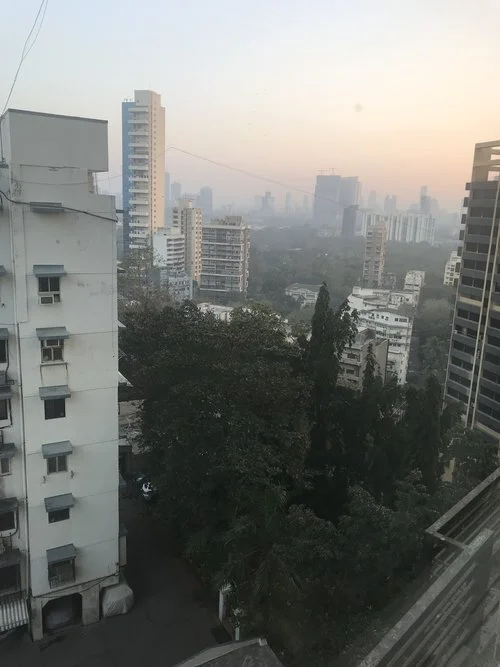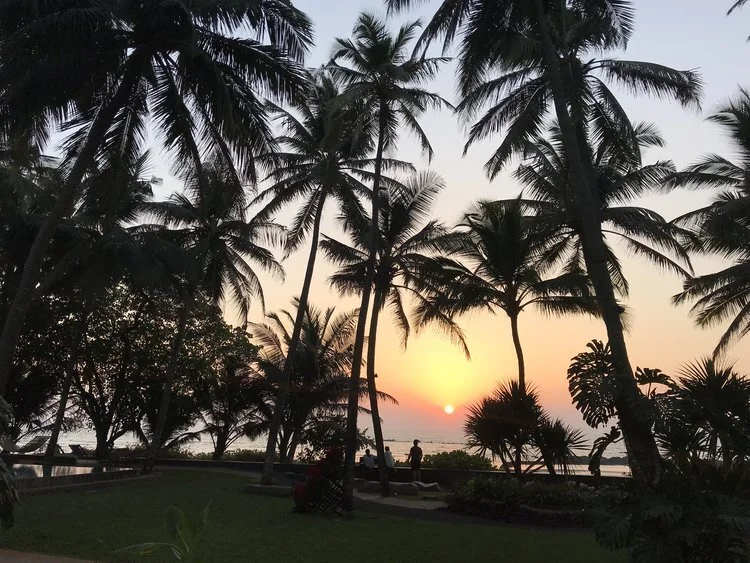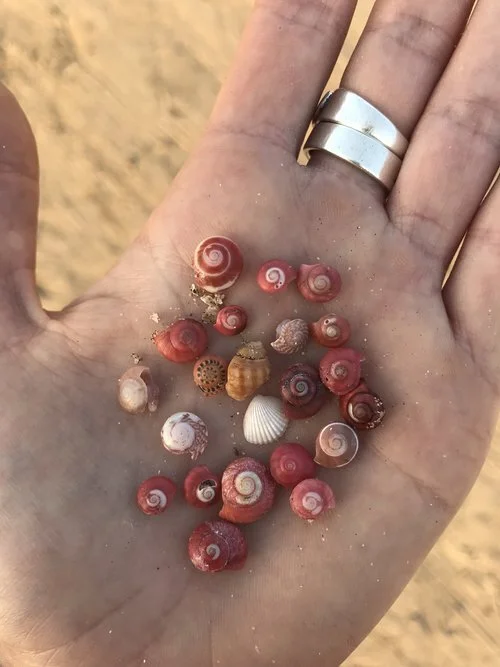A Trip to India
The clunk of the wheels deploying under the plane jerked me awake. We were landing. After 20 hours, we were finally there.
I stretched my legs out and twisted my back in my narrow seat, trying not to hit my neighbor. I find it funny how planes make people so cognizant of personal bubbles, hyper-aware of where their space ends and another person’s begins.
I peeled open the window blind and looked out at the city I would spend the next few days in, savoring those first few moments the way you might assess a new acquaintance. Gathering little bits of information, traits of personality and appearance and character to try to piece together who they are. To try to mentally reconstruct them, coloring in the details of what you don’t know.
It was early, sometime between 5am and 6am, and still dark. The lit-up grid below looked like some flattened robot, all these bright buttons, yellow and white and orange. Streams of tiny lights darted across the grid like a line of radioactive marching ants. As we got lower, I could begin to make out some details. A few skyscrapers. A bridge. They all looked delicate, breakable even, as if they were toys from a child’s dollhouse.
I’ve always loved the feeling of flying into a new place and viewing the city from above. Looking at that great big expansiveness stretching out below, of lights and cars and buildings and freeways. You feel your newness that way. Separate from it all, foreign. Everything below seems so big, stretching out for miles and miles, like it’ll eat you whole.
Perhaps that’s why whenever I fly into a city, I have this habit of imagining myself in it all. Of shifting my focus from a birds eye view down into the city. And as if I were some miniature board game piece, I put myself in it, imagining roaming the winding streets, into a cafe, along a park’s tree-lined walkway.
Seeing myself as this tiny little speck in the middle of it all, being in it, makes me see a city’s multitudes. It deconstructs the whole to show its singularities, like a buzzing swarm of bees creating the vibrating hum of a hive. There’s a satisfaction in knowing that in just a couple hours, I’ll become invisible in it all. The city swallowing me up as if I were going into the belly of a whale.
We touched down, and I made my way to customs.
“Purpose of your trip?” Personal travel.
“Where will you be visiting?” Mumbai and Kerala.
“Where will you be staying?” Friend’s house, then hotels.
“Passport?” Stamp, stamp.
And just like that, the whale of the belly opened, and India swallowed me up. I wasn’t just reading the story anymore—I was in it now.
As I made my way to the arrival lobby, the hot Mumbai air hit me. I found my name written on a white paper, standing out in stark contrast against the sea of names that rolled off my tongue like songs. Shivangi and Chandralekha and Abhishek and Aishwarya. I tried my hand at chit-chat with the driver until realizing he didn’t speak any English, and soon resorted to smiling and nodding and awkward laughs.
The sun hadn’t come up yet, and as early as it was, the streets were already choked with cars. I quickly came to the realization that there is just one general rule of thumb for driving in Mumbai: there are no rules. White traffic lanes are treated as mere suggestions, and everyone just sort of drives where they fit—be it in the lane or halfway out of it. A quick honk on the horn simply means, I’m coming up behind you or Don’t move over I’m on your side. Taking stock of the state of most cars, it quickly became apparent that this system only works about a fraction of the time.
We drove over the Bandra-Worli Sea Link, a cable bridge built over the water. What a way to enter the city. The black turbulent water all around, the moonlight catching little ripples on its surface like silver fish swimming toward the sky. The lights from the city winking at me from across the water. The city, the grid. I was entering the robot’s brain. Or perhaps its heart.
We passed by early morning joggers, running along the boardwalk. Some high-rises with big neon signs at their tops. Concrete one-story structures patched together with metal and plastic odds-and-ends like a haphazard quilt that I quickly realized were homes. Water seeping out from them into the street like leaky pipes, discarded trash long-forgotten out front. A dog bent over sniffing or drinking from the puddles.
What I couldn’t see then, I took note of later that day. Driving through the city, I realized how full Mumbai is—full of sounds, of smells, of things. Bikes ringing bells, rickshaws honking, the cough and chug of old car engines, the low gurgle of a moped, a whistle from a traffic controller, the little meep-meeps of the smaller cars. All of this held in a layer of smog that hung over the city like a thick blanket. But boy, did that smog make the sunsets beautiful. We watched it from a rooftop overlooking the water one of the first days, this big neon orange sun sinking into the Arabian Sea.
Mumbai is a coastal town, built compactly on the western edge of India. Buildings and apartments and businesses huddle tightly around the shore, stacked on top of one another. People busily scurry about between them and next to them and within them. It gives the city a feeling like it’s hunkered down, desperately clutching the earth to keep it all from washing away. Perhaps it’s the monsoons that do that to a city. Or perhaps it’s India’s volatile history, remnants of a past that was stolen from them. Now holding on to what they fought so hard to reclaim.
Mumbai is a city of change, and even its name reflects that. It all started back in 1534 when the Portuguese arrived. At the time, the region was actually a string of seven islands separated by swamps. The Portuguese quickly set up a trading center, seeing as the deep water port would serve as an ideal hub for ships. They called the islands Bom Bahia (“the good bay”) which the English mispronounced Bombay. India aside, it really is astonishing how much of history is built upon the foundation of mispronunciation.
Then, when King Charles II of England married Catherine of Braganza of Portugal in May 1662, the Portuguese handed over the territory of Bombay as part of her dowry. However, Charles had no desire to rule the islands and rented them out to the East India Trading Company. Soon, a garrison of soldiers moved in to protect the region from Dutch fleets and pirates, and the seven islands were merged together into a single land mass in an impressive early civil engineering project. The islands soon transformed from local conglomerates to a large international trading hub.
It was only until recently that Mumbai stripped itself of its colonial name. India officially gained its independence from England in 1947, ending the 282-year-long British rule in Bombay. Then in 1995, in an effort to bolster its native Indian heritage, the city’s name officially changed from Bombay to Mumbai, after Mumbadevi, a local “Mother Earth” goddess who was worshiped by the deep-sea fishermen that lived on the island prior to the arrival of the East India Company.
To this day, many locals still call the city by its former name simply because it’s the one they grew up with, despite its colonial underpinnings. Nevertheless, the symbolic gesture of renaming the city “Mumbai” has not been lost. The name carries the weight of the city’s turbulent past, a nod to its history and its future, and reclaims it as its own. It’s an understanding that change has, and will, oscillate between both ends of the spectrum, and despite many years of swinging in the wrong direction, the name serves as a tribute to its identity. To its origins.
All this to say that Mumbai is a place with a rich history, and a rich present. It’s a place that has everything going on all at once, brimming over like a too-full cup. Sights and sounds and tastes you just don’t have enough mental taste buds to capture.
So you glean what you can. The open-air farmer’s markets, long streets lined with baskets bearing exotic and brightly-colored produce: thick moringa drumsticks, bundles of curry leaves, clusters of green and yellow and red bananas, mounds of fresh ginger and turmeric, whole tamarinds, tiny baby eggplants, carrots the color of blood-oranges, piles of fragrant mint leaves, miniature melons, giant okra. The sweet smell of the frangipani flowers.
The pani puri stand, wedged between the sugar cane juice stand and the t-shirt vendor, hungry customers clustered around waiting for their little bite-sized fried crisp filled with tamarind chutney, chili, chaat masala, and chickpeas. Even the infamous sacred cows enjoy city delicacies, lazily meandering along freeways and outside store fronts, gnawing on roadside weeds.
At meals, we eat with our hands, pinching up small bites of food with flaky paratha, sweet chapati, and crispy dosa, soaking them in spiced sauces and yoghurt. Dinners are served with the soup-like lentil dahl and a glass of chaas, a spiced fermented buttermilk drink. For dessert: fresh sweet mango or maybe still-steaming baked treats with nutmeg and cardamom. In the afternoons we drink piping-hot masala tea (chai), the ginger tingling my throat, and snack on ponk, fresh sorghum with a cilantro and lime chutney.
In Mumbai, the city boasts as many colors as its food has flavors, bright and inviting and warm. Its cultural diversity makes it that much more vibrant; history has made a religious melting pot of sorts in the city: Hinduism, Islam, Buddhism, Christianity, Jainism, and Zoroastrianism. Many women wear a brightly colored sari or salwar kameez in rich oranges and pinks and blues, with delicate gold and green embroidered trim. Others wear long flowing burkas and hijabs. Still others don western shirts, jeans, and sneakers. Some girls wrap strands of Arabian Jasmine in their hair, leaving a trail of fresh floral scents wherever they go.
Near the coast, small pink shells scatter the sand, smaller than your pinky fingernail, every shade between light coral and hot pink. Banana and coconut and mango trees grow wild, clusters of green fruit hanging from their limbs. The banyan trees wind their gnarled roots around their twisted trunks like veins, knotted vines hanging down from their crowns like tangled hair. And how in the south, the giant bamboo groves creak in the wind, sounding like a haunted pirate ship straight from a Hollywood movie.
The plan was to fly from Mumbai to a region in the south called Kerala, where we’d drive from the airport in Kochi to Munnar and then on to Thekkady. Even though Kerala is just a short 2-hour plane ride from Mumbai, the locals speak an entirely different language, eat different foods, and dress differently (nearly all the men wear a short towel-like sarong called a dhoti). In the hotels, the staff greeted us by dipping their finger into a small bowl with a thick paste the color of marigolds, making a small dot in the middle of our foreheads.
In Munnar, we explored the Kerala Backwaters, lagoons and lakes winding like a labyrinth just next to the Arabian Sea. We traveled by way of a traditional vallam, our guide using a long bamboo pole to move us along, hooking it onto the bottom and pulling. I can almost smell the freshwater lake scent now, like clean seaweed. We floated past old men and women fishing on the banks with long wooden poles, kids splashing in the water under lily pads. Women doing laundry in the water, bent over, smacking clothing against the rocks. That evening, as dusk turned to night, we lay in lakeside hammocks, our faces turned skyward as we watched hundreds of giant bats fly overhead. Later, as we walked back to the hotel in the dark, we looked up to see a full moon the color of orange sherbet, the call of prayer echoing somewhere in the distance.
From Munnar, we made our way to Thekkady, a place known for its nature and wildlife. The further south we went, the greener it got. We drove by hills and hills of tea plantations. Waterfalls in the jungle. Spice and herb gardens growing cardamom and black pepper and lemongrass and cinnamon and honey. We saw wild elephants and narrowly escaped kleptomaniac monkeys. We watched sunsets from the hotel roof, the shadows racing up the sides of the mountains until they were all covered in blue-grey light. Then the stars would come out and we sat there listening to the clicking and croaking of the jungle below.
We soaked it all in as much as we could. And before we knew it, we were on a flight back to Mumbai. Then, just as quickly, on a flight back home.
Leaving the city, looking down into that same bejeweled grid when I arrived, it felt different—it always does. More worn in, not as shiny and new. Having seen its intricacies, its quirks, its shiny facades and its blemished underbelly. And yet there it was, still winking all those infinite diamonds back at me.
And as I pulled away from the city, I wondered if I’d ever be back. Mentally taking note that perhaps I should savor this moment, seeing as it could be my last, wrap it up and tuck it away in my mental repertoire. I wondered if I should practice the ritualistic mourning that comes with the end of a trip, confront the finality of it and make the transition back to reality. To suck myself out of the story, out of the belly of the whale.
But memories aren’t like that. They become part of you. The people, the places, the experiences become forever infused into your personal fabric. You don’t begin a clean new chapter when you return; you simply come back more enriched. You become more than who you were before you left. And perhaps that’s why traveling leaves us with more questions than answers. Why we feel ourselves unraveling and don’t try to stitch ourselves back together. Because maybe we aren’t looking for answers at all, but guidance.
In Hindi (one of the official languages of India) the greeting for both hello and goodbye is the same: namaste. It hints at the cyclical nature of time, of how it’s impossible to distinguish where endings begin and where beginnings end.
Because the thing is, endings aren’t endings at all. Nor are beginnings. Life isn’t that black and white. Other than birth and death, we don’t get hard stops, hard restarts. Life is this continuous flow from where we were to where we’re going, with just a brief layover in the present. Every single one of us, we’re each just this great big wild hurricane-snowball traveling through time, picking up places and people and experiences along the way. And over time, we accumulate moments of love and fear and happiness and uncertainty and clarity and confusion. We learn and we grow and we change.
As the plane ascended into the sky, I realized that flying home wasn’t an ending. It was merely a shift in my rudders pointing me in a new direction. Of change. Bombay, Mumbai, new syllables to carry the stories of the past through time. In the end, flying home was simply a continuation of the same chapter, albeit by a new name. Namaste.








